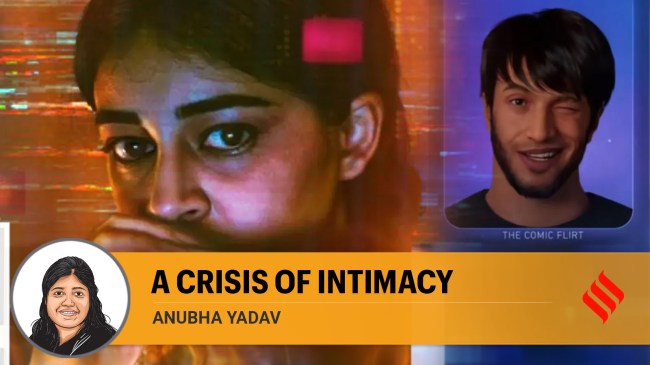Opinion How to forget your ex — with a little help from AI
The film, starring Ananya Pandey, reveals the complexities of our many lived selves today, where forgetting a romantic relationship feels as unreal as it is accessible.
 CTRL makes you wonder about the nature of memory and its relationship with romantic love and forgetting. (File Photo)
CTRL makes you wonder about the nature of memory and its relationship with romantic love and forgetting. (File Photo) Exactly 20 years ago, Eternal Sunshine of the Spotless Mind (ESSM) gave us a visceral visual language for the erasure of our romantic past. In the film, Clementine Kruczynski (Kate Winslet) uses a service, Lacunae, to have a procedure which erases her memories of her ex, Joel Barish (Jim Carrey). Clementine chooses to do so as an act of clinical moving on, with none of the messiness typical of romantic love. When Joel finds out about this, he decides to do the same. Joel’s counter-erasure is an act of revenge because Clementine has broken the cardinal pact about the organic journey of a break-up which entails living with each other’s memories, as one waits for time to dull the pain. Slotted as a science fiction film in 2004, Eternal Sunshine of the Spotless Mind became a cult classic about the violence of forgetting.
Vikramaditya Motwane’s CTRL is based in today’s world. Nella (Ananya Pandey) and Joe (Vihaan Samant) are a popular social media influencer couple, who run a digital brand based on their life as a couple. Just after her public break-up with Joe, Nella’s pain of being betrayed is totally subsumed by her fear of losing her followers. For Nella, reclaiming her life is reclaiming her digital life. Thus, hope of a new life is in Joe’s total digital erasure from her computer and social media. So, much like Joel’s brain is cleaned of Clementine as he sleeps, Nella’s life is cleaned of Joe every night. While Joel and Clementine had Dr Howard’s procedure, Nella has an AI assistant called Allen, whose digital wink reminds you of Jim Carrey. In CTRL, forgetting starts by removing the digital trail, regaining your followers and slowly creating new digital memories. Nella quickly curates a new flashy life sans Joe. In short, a spotless digital life leads to a spotless mind.
CTRL makes you wonder about the nature of memory and its relationship with romantic love and forgetting. It makes you question whether the embodiment of memory itself has changed today and if Charlie Kaufman’s spotless script for the 2004 film was, in fact, prescient. In ESSM, the process of erasure triggered the memory of the actual event and revealed more about Joel and Clementine’s relationship, whereas in CTRL, the captured moment’s memory is just an isolated rupture, a digital ghost which reveals little about Joe and Nella’s relationship to the audience.
Over time, the act of forgetting has changed its material presence in our lives. It used to be sad songs and distraught faces at one time. Then it took the form of burnt journals, broken Archies mugs and torn photographs. Today, forgetting takes the form of password-locked digital folders of past loves never to be visited again. Perhaps we are living in an age where forgetting is most unreal and yet easily accessible — so accessible that it has become a convenience store. Unlike ESSM in which forgetting was still sensory, in CTRL its visualisation is largely linear and intellectual. Perhaps, it is no more “forgetting”. Acclaimed psychotherapist and relationship expert Esther Perel warns us against another “AI” on the rise — “Artificial Intimacy”, she says, is robbing generations of the capacity to build and experience real connections. Perel says we are living in a crisis of intimacy enabled by Artificial Intelligence. This is succinctly reflected in CTRL when Joe asks Nella: Did you really come there to surprise me? Or did you just do it for the likes? CTRL reflects the complexity of our many lived selves today, between Joe’s interrogation of what he feels for Nella and Nella’s assumption that the erasure of the photographs and videos will mean the erasure of Joe from her life.
As soon as I finished watching CTRL on Netflix, I opened another app to enable my evening walk. Armed with my smartphone and airpods, I disconnected from my surroundings again as I dived into my favourite podcast, shifting from one mode of technology to another — one in the bedroom and the other in the public park. Just as I left home, my mother, who had been catching the film in short snatches, asked me, “So, did the two meet in the end?” I sighed and wondered if questions reveal the generation we are born in.
Is analogue love more real than Nella’s choice to return to the AI version of Joe?
Just as I enter the park, I see a young couple enter with their smartphones in their hands. In the twilight, they start making videos of empty swings on their smartphones. They don’t exchange a word with each other as their eyes stay glued to their phones. Real life Nella and Joe, I think. The young man pushes the empty swings and then moves away so his girlfriend can shoot them. I’m determined to rupture our digital silos, so I walk up to them. I tell them I am talking to you inspired by the film, I’m breaking “the spell” I say. We chat as our phones rest in our pockets. They tell me how they have been walking around the city the whole evening, trying to document how children don’t come to parks now. Their little hobby project is to get children to parks again. Suddenly, my Nella and Joe have a new avatar. They are activists working against the moment we are caught in, looking to find something real inside AI.
Yadav is an academic, writer and filmmaker






